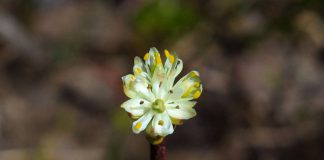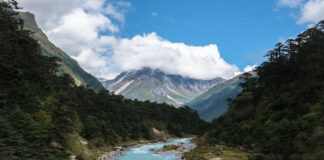JANUARY 1, 2021
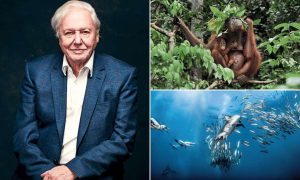
The world’s greatest living explorer is planning his travels again. Once the end of the Covid tunnel is finally in sight, Sir David Attenborough is itching to make up for lost time – and he knows where he’s going first. ‘Europe,’ he says.
‘I don’t know it as well as I might.’ This is a man who went hot-air ballooning in the Swiss Alps when he turned 90 (he’s 94 now), so don’t imagine he’s a stranger to the Continent.
He’s also adamant about where he will not be going. ‘I don’t need to get back to the South Pole, or the North Pole. My dear friend Alastair took me to both. There is nothing there at all in terms of animals.’
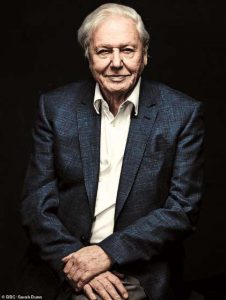
Sir David Attenborough (pictured) is itching to resume travels once the end of the Covid tunnel is finally in sight and hopes to start with Europe
The veteran TV producer Alastair Fothergill, who is listening in on our interview via laptop, winces. Their trip to the North Pole, he admits, almost ended in catastrophe when the ice shelf that formed their plane’s runway disintegrated moments after they got into the air.
The fact is, it would be difficult to find anywhere on the planet that Sir David has not visited during 66 years of filming wildlife documentaries, beginning with the first Zoo Quest to Sierra Leone in West Africa in 1954. His latest series, A Perfect Planet on BBC1, starts tomorrow with an episode about the power of volcanoes.
It has footage of iguanas in the Galapagos Islands, risking their lives to clamber into the bowl of the crater of the La Cumbre volcano on Fernandina island. Here they lay their eggs to incubate in the natural heat.
There is loose scree inside, and as the lizards scramble for a foothold they can easily dislodge boulders that bounce down to crush whatever is below – other iguanas, or film cameramen. As one of the creatures loses its footing and starts to tumble, before saving itself at the last moment, it is heart-in-the-mouth viewing.
When I make the mistake of wondering whether this was previously unknown behaviour, Sir David arches a mischievous eyebrow. ‘I have seen that before,’ he remarks, ‘and I’ve been in that volcano.’
What he doesn’t mention is that he and his crew, who visited Fernandina for the Natural World series in 1998, are the only people before now ever to have filmed the iguanas’ death-defying descent. What’s more, they didn’t have the benefit of drones, which have made pin-sharp, close-up aerial photography possible for the first time.
Until these rotor-copter cameras were developed, filming from the air meant helicopters or light aircraft. The noise and downdraught often spooked the animals, making it impossible to observe their natural behaviour. Drones have changed the look of documentaries forever.
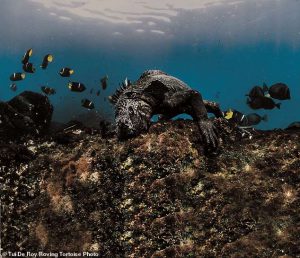
Hot and cold: Marine iguanas can stay submerged for up to half an hour, scraping algae from the rocks with their beak-like mouths. Though they look savage, they are actually vegan. But they’re tough – the waters where they feed, such as off Fernandina Island in the Galapagos, can be as cold as 11°C. To regenerate their energy they lie in the sun, soaking up warmth with their dark skin. Heat cameras have shown their core temperature rises from half-frozen to hotter than a human
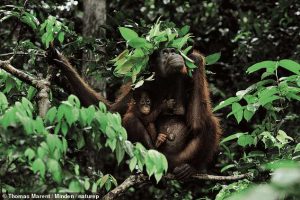
Natural umbrella: This baby orangutan and parent have learned to shelter under leaves during the monsoon in Tanjung Puting National Park in Indonesia. This has been a game reserve since 1935, and is one of the best places to see wild orangutans
‘I do think about how different earlier series may have looked if we’d had some of the technology we do now,’ says Sir David, ‘But you want to be half a mile ahead of viewers’ expectations, rather than five miles ahead.
‘For its time, Life On Earth [in 1979] featured remarkable stuff simply because it had animals that people had never seen before. It is of its era, and it was pretty good.
One wonders how long we can go on improving the technology at the rate that we’ve been doing in my lifetime. It started with clockwork cameras and black-and-white film. How on earth can we get better than we’ve got now?’
He is a fan of Springwatch, not only for the erudition of presenter Chris Packham (‘he is so absolutely loaded with facts, you feel that when he sits on a chair they’re going to drip out of him’) but also for the innovations in filming the show has pioneered.
Fixed cameras watching nests and dens reveal wildlife at the animals’ own pace, while footage captured by viewers on mobile phones might lack technical sophistication but often reveals wild behaviour that has never been filmed.
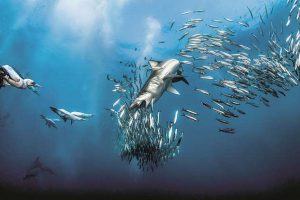
Teamwork: One of the hardest phenomena to film – it often only lasts ten minutes – is the ‘baitball’, where super-pods of dolphins corral giant shoals of fish into tight balls to gobble them up. Oceanic blacktip sharks, sealions and whales join in, while gannets and shearwaters dive in from above
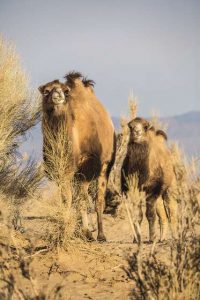
Got the hump: Wild Bactrian camels like this mother and calf can scent water 30 miles away. The crew in the Gobi desert were likely the only humans in an area the size of the Netherlands, and the shy camels will run when they’re still three miles away – so this shot is impressive
In the end, though, Sir David feels that technology is merely a tool. ‘It is not the individual shots, it is the story. And if you are a good enough storyteller, you can get away with everything else. Narrative structure is the most important element, and being good at it without distorting facts.’
The facts of climate change are what he is most determined to address in this new five-part series. Each episode looks at an elemental force: volcanoes, the sun, weather patterns, ocean currents, and human activity.
The first four of these, he says, combine to create the ‘Goldilocks’ conditions of our planet – neither too hot nor too cold, with an atmosphere and range of habitats that enable an extraordinary diversity of life.
‘Our planet is one in a billion,’ he says at the start of the series. ‘But a new dominant force is changing the face of the Earth: humans. To preserve our perfect planet we must ensure we become a force for good.’
In private, he is more deeply concerned about the immediate future than his voiceover reveals. ‘Everyone now understands that, worldwide, we are at a crucial point. Our planet is facing global threats. We can stop them, but we have to understand what they are and how they work.
‘Looking at it from my point of view in my 90s,’ he says, with a warning note creeping into his voice, ‘the long-term things are not what worry me most. It’s now the short-term things that threaten us. There will be an irreversible turning point.
‘If the Arctic ice suddenly melts, we will feel that within months of the change. It could happen catastrophically. When you consider that so many of our great global cities are on the coastlines, that could have a huge effect on urban lives. Their defences could be completely overwhelmed.’
Despite a lifetime in conservation, he sees little indication that the wild world can withstand deforestation and global warming. In particular, he is anxious about coral reefs such as the Great Barrier Reef, natural wonders that are highly sensitive to changes in sea temperatures.
But he is more optimistic about the gradual change in public attitudes. ‘I’ve been working in this area for a long time, and it used to be that if you tried to talk about extinctions and habitat loss, people would dismiss you: “He’s a nice chap, but there’s no reason to get over-excited.”
‘Later, when they saw there was genuinely a reason to get over-excited, they still put it off: “If we have to be concerned, let’s wait till next year.” That is not the mood now. Children are feeling it strongly and teachers are doing a wonderful job to make kids aware.
‘It has to be taught carefully. We don’t want to terrify children, but it is vitally important they understand we must look after the natural world.’
He has little patience for the anarchic behavior of Extinction Rebellion activists, however. ‘I hesitate about supporting anybody that talks about breaking the law,’ he says, with careful understatement.
‘The law is what we are going to have to use to get what we want. You can’t break the law this year and use it to impose rules on people who disagree with you next year.
‘Everybody is entitled to their point of view, but if we are going to have a wide, powerful, popular movement, it has to be a lawful one. Otherwise it won’t get the democratic support that it needs.’
He is an enthusiastic supporter, though, of the idea that we can all help to save the planet – everyone has a part to play. ‘The one thing I ask is that we reduce the demands each one of us makes on the planet – what we eat, what we throw away, what we use for power – to ensure we don’t produce more carbon dioxide.
‘I keep reminding myself that there are three times as many people on the planet as when I started making TV programmes. We have to behave with some restraint. If all of us did that, the problem would be solved.’
If we don’t, he warns, the chaos of 2020 and the pandemic will seem like ‘a minor malfunction’ in comparison to ‘the greater malfunction that is on its way’. Incapable of pessimism for long, he draws encouragement from the lessons of lockdown.
‘I’ve never listened to so much birdsong,’ he says. ‘Nature has come back under lockdown, and I’ve been able to spend more time in my garden.
‘I’ve been very lucky. Where I live I get an overflow of birds from Richmond Park. I see many that you may not expect in a suburban garden, such as green woodpeckers. In the spring, a peregrine falcon was nesting in the church tower near me.’
It’s a pleasure that millions of others have shared since restrictions began, and Sir David believes it can pay surprising dividends. ‘Lockdown has made us aware of nature in ways we never have been before. People have become more aware of our planet’s precious natural balance.
‘We are part of that balance. It’s part of us, and if it goes wrong we’re in trouble. The pandemic is only a small example of how wrong it can go. There are bigger problems ahead – together, we can solve them.’
Courtesy/Source: Daily Mail
































































































